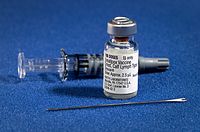
Photo from wikipedia
Simple Summary The purpose of this study was to describe vaccinal strain detection using qPCR on blood samples collected from due-to-wean piglets after a mass vaccination of their dams with… Click to show full abstract
Simple Summary The purpose of this study was to describe vaccinal strain detection using qPCR on blood samples collected from due-to-wean piglets after a mass vaccination of their dams with a modified live vaccine in five positive stable herds with different management practices including external and internal biosecurity measures. Abstract Data concerning PRRSV-1 vaccine virus strains dissemination within vaccinated sow herds are scarce. However, it is a big concern for swine practitioners when designing the PRRSV diagnostics strategy in vaccinated farms. At the same time, the possibility of vaccine virus transmission from sows to their offspring is important to have in mind in order to limit the risk of recombination between different PPRSV-1 modified live virus vaccine (MLV1) when both sows and piglets have to be vaccinated. This study was conducted in five PRRSV-stable breeding herds. The selected farms presented different characteristics regarding production parameters and biosecurity management practices in order to be, as much as possible, representative of French swine production herds. In four different batches following a sow mass vaccination with a PRRSV-1 modified live virus vaccine (ReproCyc® PRRS EU, Boehringer Ingelheim, Ingelheim, Germany), we failed to detect the vaccine virus in due-to-wean piglets in all of the herds. This should mean that the dissemination of the vaccinal strain is a rare event, even just after a sow vaccination, at least for the vaccine tested in our study.
Journal Title: Veterinary Sciences
Year Published: 2023
Link to full text (if available)
Share on Social Media: Sign Up to like & get
recommendations!